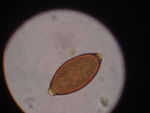Difference between revisions of "Trichuris vulpis"
| Line 2: | Line 2: | ||
[[File:Trichuris Egg.jpg|150px|thumb|right|Trichuris vulpis egg - Joel Mills, Wikimedia commons]] | [[File:Trichuris Egg.jpg|150px|thumb|right|Trichuris vulpis egg - Joel Mills, Wikimedia commons]] | ||
===Overview=== | ===Overview=== | ||
| − | ''Thrichuris vulpis''is a typical whipworm in appearance and life cycle. It inhabits the large intestine and ceacum of dogs and less often foxes and cats worldwide. Commonly seen in the caecum, but rarely in large enough quantities to cause clinical signs. | + | ''Thrichuris vulpis''is a typical whipworm in appearance and life cycle. The worms have a pre-patent period of 3 months before eggs are found in feaces, though they are not always present and several samples may be necessary to confirm infection. It inhabits the large intestine and ceacum of dogs and less often foxes and cats worldwide. Commonly seen in the caecum, but rarely in large enough quantities to cause clinical signs, most notably diarrhoea in dogs. |
===Identification=== | ===Identification=== | ||
| − | Adults are between 4.5 and 8cm long, slender and white coloured. The anterior end is long and filamentous becoming broader towards the posterior. | + | Adults are between 4.5 and 8cm long, slender and white coloured. The anterior end is long and filamentous becoming broader towards the posterior. The males tail is coiled and has a single spicule, used for reproduction, in a protrusible sheath. |
| + | Eggs are distinctive lemon shaped with a thick shell and bioperculated having plugs at each pole. The eggs appear yellow/brown colour in the faeces. | ||
| − | + | [[Category:Trichinelloidea]] | |
| − | + | [[Category:Dog_Nematodes]] | |
| − | |||
[[Category:To_Do_-_NickJ]] | [[Category:To_Do_-_NickJ]] | ||
Revision as of 12:20, 12 July 2010
| This article is still under construction. |
Overview
Thrichuris vulpisis a typical whipworm in appearance and life cycle. The worms have a pre-patent period of 3 months before eggs are found in feaces, though they are not always present and several samples may be necessary to confirm infection. It inhabits the large intestine and ceacum of dogs and less often foxes and cats worldwide. Commonly seen in the caecum, but rarely in large enough quantities to cause clinical signs, most notably diarrhoea in dogs.
Identification
Adults are between 4.5 and 8cm long, slender and white coloured. The anterior end is long and filamentous becoming broader towards the posterior. The males tail is coiled and has a single spicule, used for reproduction, in a protrusible sheath. Eggs are distinctive lemon shaped with a thick shell and bioperculated having plugs at each pole. The eggs appear yellow/brown colour in the faeces.
